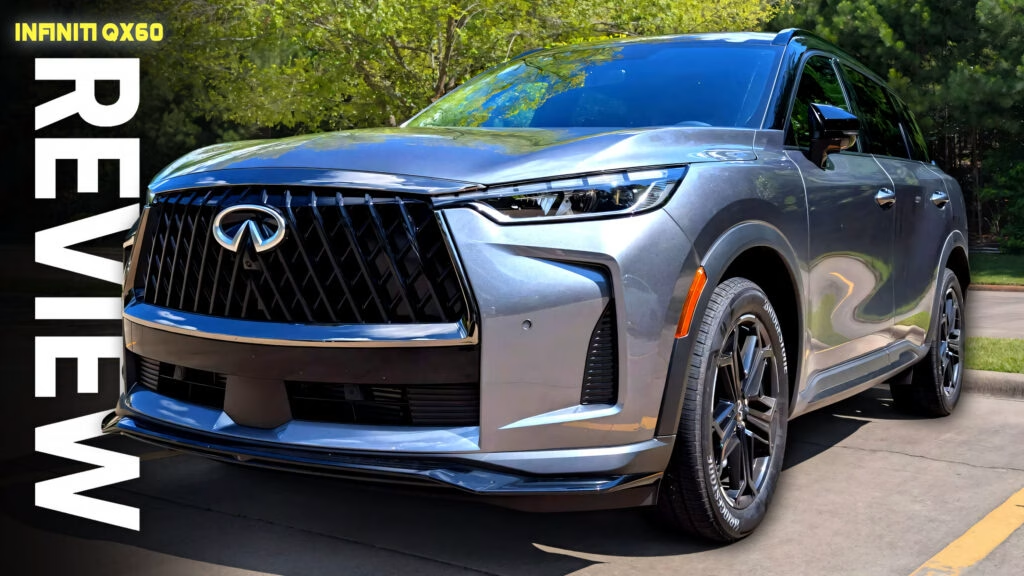Is the 2026 Infiniti QX60 Sport Really Worth Your Attention?
What Stands Out About the QX60’s Design?
Let’s be honest: most three-row SUVs blend into the background. The 2026 Infiniti QX60 Sport, though, makes you do a double take. Infiniti’s designers clearly put in overtime, crafting a look that’s both athletic and upscale. The bold front grille, sharp LED headlights, and sculpted flanks give it real presence—think QX80’s swagger with a sleeker, more modern twist. Our test model’s Graphite Shadow paint and jet-black roof combo looked especially sharp, and little touches like the upward-tapering side skirt and blacked-out trim show real attention to detail.
In a parking lot full of vanilla crossovers, the QX60 stands out. If curb appeal is high on your list, this Infiniti delivers in spades.
How Does the Interior Stack Up for Families?
Step inside and you’re greeted by a cabin that tries to blend Infiniti’s old-school luxury with modern touches. There are sweeping curves, open-pore wood, and leather everywhere you look. The blue-on-black color scheme feels fresh, and the switchgear is satisfyingly solid. The center console’s asymmetrical design is a love-it-or-hate-it affair, but at least everything’s logically placed.
Front seats are plush and supportive, with both heat and ventilation (though the cooling isn’t the strongest). The second row is roomy and heated as well. The third row? Let’s call it “emergency use only”—adults will feel cramped, and even kids might complain on longer trips. Plus, those third-row headrests block your rearview unless you fold them down, which isn’t ideal if you’re carrying passengers back there.
Cargo flexibility is decent, but the seat-folding process is manual and a bit clunky. Still, you can fit a full-size mountain bike with the rear rows down—no small feat for a midsize SUV. And with a 6,000-lb towing capacity, the QX60 can handle a family camper or boat without breaking a sweat.
Does the Tech Feel Modern or Dated?
Here’s where things get a bit dicey. The QX60’s infotainment system is functional and reasonably intuitive, splitting climate and media controls between a touchscreen and physical knobs. The screen’s haptic feedback is a nice touch, but the glossy black plastic is a fingerprint magnet.
The real letdown is the driver-assist tech. Infiniti’s ProPilot Assist 1.1 is standard, but it feels a generation behind. It requires you to keep a hand on the wheel and can be overly sensitive—try to correct its lane-keeping and you’ll get a chorus of beeps. After sampling Nissan’s newer ProPilot 2.1 (which allows hands-free driving on highways), this older system feels outclassed, especially in a $60,000 SUV.
What’s It Like to Drive the QX60 Sport?
On paper, the QX60’s 2.0-liter turbocharged four-cylinder (268 hp, 286 lb-ft) and eight-speed automatic sound promising. In reality, the driving experience is… fine. Not bad, not great. Just fine.
Acceleration is adequate, but the engine’s variable compression tech doesn’t translate to much excitement. There’s a noticeable lag before the power comes on, and when it does, it’s more of a steady push than a surge. The transmission is smooth but not especially quick to respond. Handling is safe and predictable, but don’t expect the kind of engagement you’d get from a Mazda CX-90 or Acura MDX.
For daily commuting and highway cruising, the QX60 is quiet and comfortable. But if you’re hoping for a sporty edge to match its looks, you’ll be left wanting.
How Does Fuel Economy Measure Up?
Infiniti claims 22 mpg city, 27 highway, and 24 combined. In our real-world testing—mixed city and highway—we averaged just 19.5 mpg. That’s a noticeable gap, especially considering the QX60’s four-cylinder engine. For comparison, the V6-powered Nissan Pathfinder Rock Creek we tested previously returned similar numbers.
If you’re hoping the QX60 will save you money at the pump compared to rivals, think again. It’s not a gas guzzler, but it’s not a standout, either.
How Does the QX60 Compare to Other Three-Row SUVs?
Starting at $53,200 and climbing to $66,150 for a loaded model, the QX60 sits right in the thick of the midsize luxury SUV market. The problem? Its competition is fierce.
The Nissan Pathfinder offers similar space, more power, and a better driving experience for about $10,000 less. The Kia Sorento and Hyundai Santa Fe deliver comparable features at a lower price. Meanwhile, the Mazda CX-90 and Acura MDX offer sharper handling, and the Volvo XC90, Lexus TX, and Audi Q7 bring more luxury and advanced tech for similar money.
The QX60’s main advantage is its style. Beyond that, it doesn’t lead the class in any meaningful way—be it performance, technology, or value.
What’s the Real-World Verdict?
Here’s the bottom line: the 2026 Infiniti QX60 Sport is a head-turner with a comfortable cabin and solid towing chops. But when you dig deeper, it’s clear Infiniti played it too safe. The driving experience is middling, the tech is a step behind, and the third row is best left to kids or short trips.
If you’re drawn to the QX60’s looks and don’t mind paying a premium for style, it’ll serve you well as a family hauler. But if you want the best blend of luxury, performance, and value, there are better options out there.
The big takeaway? Buying a three-row SUV isn’t about finding perfection—it’s about picking the trade-offs that matter most to you. Start with one priority—maybe it’s style, maybe it’s tech, maybe it’s space—and you’ll spot the right fit by month’s end.

